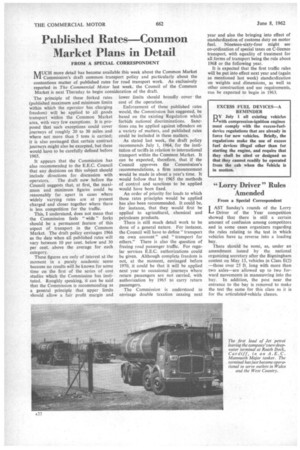Published Rates—Common Market Plans in Detail
Page 24

If you've noticed an error in this article please click here to report it so we can fix it.
FROM A SPECIAL CORRESPONDENT
MUCH more detail has become available this week about the Common Market Commission's draft common transport policy and particularly about the contentious matter of published rates for road transport work. As exclusively reported in The Commercial Motor last week, the Council of the Common Market is next Thursday to begin consideration of the draft.
The principle of these forked rates (published maximum and minimum limits within which the operator has charging freedom) will be applied to all goods transport within the Common Market area, with very few exceptions. It is proposed that such exceptions could cover journeys of roughly 20 to 30 miles and where not more than 5 tons is carried; it is also envisaged that certain contract journeys might also be excepted, but these would have to be carefully defined before 1965.
It appears that the Commission has also recommended to the E.E.C. Council that any decisions on this subject should include directions for discussion with operators. The draft now before the Council suggests that, at first, the maximum and minimum figures could he reasonably far apart in cases where widely varying rates are at present charged and closer together where there is less competition for the traffic.
This, I understand, does not mean that the Commission feels " wide " forks should be a permanent feature of this aspect of transport in the Common Market. The draft policy envisages 1966 as the date when all published rates will vary between 10 per cent, below and 30 per cent. above the average for each category.
These figures are only of interest at the moment in a purely academic sense because no results will be known for some time on the first of the series of cost studies which the Commission has instituted. Roughly speaking, it can be said that the Commission is recommending as a general principle that upper limits should allow a fair profit margin and
lower limits should broadly cover the cost of the operation.
Enforcement of these published rates would, the Commission has suggested, be based on the existing Regulation which forbids national discriminations. Sanctions can be applied against Offenders on a variety of matters, and published rates could be included in these matters.
As stated last week, the draft policy recommends July 1, 1964, for the institution of tariffs in relation to international transport within the Common Market. It can be expected, therefore, that if the Council approves the Commission's recommendations, a firm announcement would be made in about a year's time. It would follow that by 1965 the methods of control and sanctions to be applied would have been fixed.
An order of priority for loads to which these rates principles would be applied has also been recommended. It could be, for instance, that they would first be applied to agricultural, chemical and petroleum products.
There is still much detail work to be done of a general nature. For instance, the Council will have to define "transport on own account" and "transport for others." There is also the question of freeing road passenger traffic. For regular services E.E.C. authorizations could be given. Although complete freedom is not, at the moment, envisaged before 1970, it could be that it will be applied next year to occasional journeys where return passengers are not carried, with authorization by 1965 to carry return passengers.
The Commission is understood to envisage double taxation ceasing next year and also the bringing into effect of standardization of customs duty on motor fuel. Nineteen-sixty-four might see co-ordination of special taxes on C-licence transport, with equality of treatment for all forms of transport being the rule about 1968 or the following year.
It is expected that the first traffic rules will be put into effect next year and (again as mentioned last week) standardization on weights and dimensions, as well as other construction and use requirements, can be expected to begin in 1963.




































































































